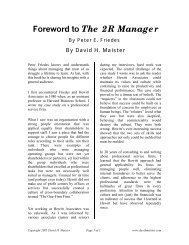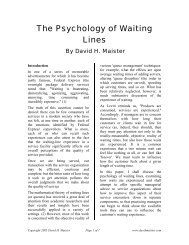pdf version - David Maister
pdf version - David Maister
pdf version - David Maister
Create successful ePaper yourself
Turn your PDF publications into a flip-book with our unique Google optimized e-Paper software.
Marketing is a Conversation<br />
8. Instead of worrying about your logos<br />
and the appearance of your written<br />
materials, pay attention to your<br />
physical space ensuring that it is<br />
designed to encourage true<br />
conversation.<br />
For example, you can take the tables out<br />
of some of your conference rooms. You<br />
can turn one wall into a white board on<br />
which participants can write as ideas<br />
emerge. You can make another wall a<br />
cork board for sticky notes so that ideas<br />
can be attached as conversations unfold.<br />
If you want clients to engage, create an<br />
environment that facilitates this!<br />
9. Instead of spending their time<br />
planning and strategizing, get your<br />
firm’s leaders to conduct a series of key<br />
“royalty to royalty” meetings outside of<br />
formal presentations.<br />
Clients are skeptical about powerful<br />
CEOs or managing partners who show<br />
up for key sales presentations or “beauty<br />
parades,” never to be heard from or seen<br />
again. It’s an old idea, but still an<br />
underutilized one: use your senior<br />
officers to have meetings with senior<br />
client officers, talking to each other<br />
about issues in a way that the mere<br />
mortals serving clients day-to-day may<br />
not be able to do. The goal of good<br />
marketing is not only to create more<br />
conversations. It is to create more kinds<br />
of conversations that will lead to new<br />
insights, stronger relationships and better<br />
ways of working together.<br />
Some guidelines for creating and<br />
conducting effective conversations<br />
So far, we have discussed some of the<br />
opportunities that professionals and their<br />
firms have to create conversations. Now<br />
let’s turn to the topic of how you ensure<br />
that you are skilled, engaging<br />
conversationalists in all of your<br />
marketing activities.<br />
Think of a dinner party conversation.<br />
What makes a good conversationalist at<br />
a dinner party? He or she:<br />
• Has a fresh point of view, but does<br />
not try to thrust it upon everyone else<br />
• Speaks politely and respectfully<br />
• Tells good stories to illustrate key<br />
points<br />
• Is good at drawing other people’s<br />
views out and drawing them into the<br />
conversation<br />
• Speaks intelligently on a variety of<br />
subjects, but is not afraid to admit<br />
areas of ignorance<br />
• Avoids trotting out well-worn<br />
arguments that have been made time<br />
and time again<br />
• Listens with genuine interest<br />
• Is light-hearted in style, but always<br />
respectful of other’s views<br />
All of these conversational skills also<br />
apply in effective marketing. You may<br />
remember to behave this way at a dinner<br />
party, but do your sales meetings really<br />
meet these criteria? What about your<br />
seminars, speeches, articles, blogs, and<br />
websites?<br />
The tone of the experience you provide<br />
clients in your marketing efforts should<br />
be friendly; it should invite people in to<br />
chat and to think about ideas; and it<br />
should encourage both sides to get to<br />
know each other as people.<br />
This, of course, requires that you are<br />
comfortable in your own skin, and that<br />
you are who you are. Much of traditional<br />
marketing is designed so that people<br />
aren’t required to put their own<br />
humanity on display. They hide behind<br />
Copyright 2006 <strong>David</strong> <strong>Maister</strong> and Lois Kelly Page 6 of 9 www.davidmaister.com











